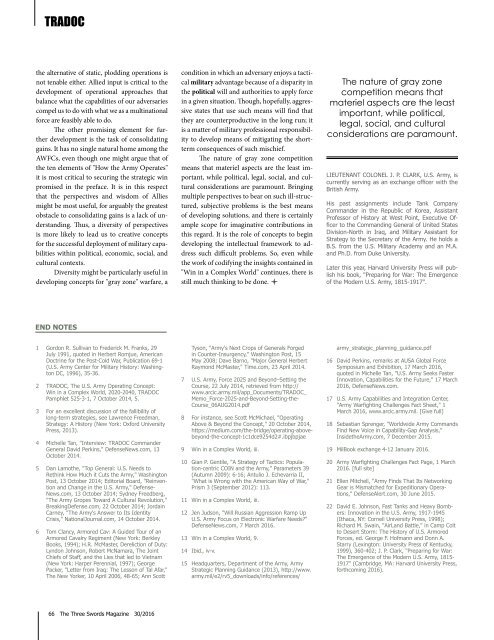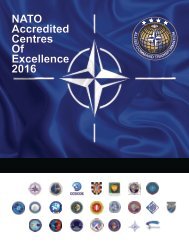TRIDENT ISSUE
7201_JWC_May2016_Magazine_ORIG_Low
7201_JWC_May2016_Magazine_ORIG_Low
You also want an ePaper? Increase the reach of your titles
YUMPU automatically turns print PDFs into web optimized ePapers that Google loves.
TRADOC<br />
the alternative of static, plodding operations is<br />
not tenable either. Allied input is critical to the<br />
development of operational approaches that<br />
balance what the capabilities of our adversaries<br />
compel us to do with what we as a multinational<br />
force are feasibly able to do.<br />
The other promising element for further<br />
development is the task of consolidating<br />
gains. It has no single natural home among the<br />
AWFCs, even though one might argue that of<br />
the ten elements of "How the Army Operates"<br />
it is most critical to securing the strategic win<br />
promised in the preface. It is in this respect<br />
that the perspectives and wisdom of Allies<br />
might be most useful, for arguably the greatest<br />
obstacle to consolidating gains is a lack of understanding.<br />
Thus, a diversity of perspectives<br />
is more likely to lead us to creative concepts<br />
for the successful deployment of military capabilities<br />
within political, economic, social, and<br />
cultural contexts.<br />
Diversity might be particularly useful in<br />
developing concepts for "gray zone" warfare, a<br />
condition in which an adversary enjoys a tactical<br />
military advantage because of a disparity in<br />
the political will and authorities to apply force<br />
in a given situation. Though, hopefully, aggressive<br />
states that use such means will find that<br />
they are counterproductive in the long run; it<br />
is a matter of military professional responsibility<br />
to develop means of mitigating the shortterm<br />
consequences of such mischief.<br />
The nature of gray zone competition<br />
means that materiel aspects are the least important,<br />
while political, legal, social, and cultural<br />
considerations are paramount. Bringing<br />
multiple perspectives to bear on such ill-structured,<br />
subjective problems is the best means<br />
of developing solutions, and there is certainly<br />
ample scope for imaginative contributions in<br />
this regard. It is the role of concepts to begin<br />
developing the intellectual framework to address<br />
such difficult problems. So, even while<br />
the work of codifying the insights contained in<br />
"Win in a Complex World" continues, there is<br />
still much thinking to be done. <br />
The nature of gray zone<br />
competition means that<br />
materiel aspects are the least<br />
important, while political,<br />
legal, social, and cultural<br />
considerations are paramount.<br />
LIEUTENANT COLONEL J. P. CLARK, U.S. Army, is<br />
currently serving as an exchange officer with the<br />
British Army.<br />
His past assignments include Tank Company<br />
Commander in the Republic of Korea, Assistant<br />
Professor of History at West Point, Executive Officer<br />
to the Commanding General of United States<br />
Division-North in Iraq, and Military Assistant for<br />
Strategy to the Secretary of the Army. He holds a<br />
B.S. from the U.S. Military Academy and an M.A.<br />
and Ph.D. from Duke University.<br />
Later this year, Harvard University Press will publish<br />
his book, "Preparing for War: The Emergence<br />
of the Modern U.S. Army, 1815-1917".<br />
END NOTES<br />
1 Gordon R. Sullivan to Frederick M. Franks, 29<br />
July 1991, quoted in Herbert Romjue, American<br />
Doctrine for the Post-Cold War, Publication 69-1<br />
(U.S. Army Center for Military History: Washington<br />
DC, 1996), 35-36.<br />
2 TRADOC, The U.S. Army Operating Concept:<br />
Win in a Complex World, 2020-2040, TRADOC<br />
Pamphlet 525-3-1, 7 October 2014, 5.<br />
3 For an excellent discussion of the fallibility of<br />
long-term strategies, see Lawrence Freedman,<br />
Strategy: A History (New York: Oxford University<br />
Press, 2013).<br />
4 Michelle Tan, "Interview: TRADOC Commander<br />
General David Perkins," DefenseNews.com, 13<br />
October 2014.<br />
5 Dan Lamothe, "Top General: U.S. Needs to<br />
Rethink How Much it Cuts the Army," Washington<br />
Post, 13 October 2014; Editorial Board, "Reinvention<br />
and Change in the U.S. Army," Defense-<br />
News.com, 13 October 2014; Sydney Freedberg,<br />
"The Army Gropes Toward A Cultural Revolution,"<br />
BreakingDefense.com, 22 October 2014; Jordain<br />
Carney, "The Army's Answer to Its Identity<br />
Crisis," NationalJournal.com, 14 October 2014.<br />
6 Tom Clancy, Armored Cav: A Guided Tour of an<br />
Armored Cavalry Regiment (New York: Berkley<br />
Books, 1994); H.R. McMaster, Dereliction of Duty:<br />
Lyndon Johnson, Robert McNamara, The Joint<br />
Chiefs of Staff, and the Lies that led to Vietnam<br />
(New York: Harper Perennial, 1997); George<br />
Packer, "Letter from Iraq: The Lesson of Tal Afar,"<br />
The New Yorker, 10 April 2006, 48-65; Ann Scott<br />
Tyson, "Army's Next Crops of Generals Forged<br />
in Counter-Insurgency," Washington Post, 15<br />
May 2008; Dave Barno, "Major General Herbert<br />
Raymond McMaster," Time.com, 23 April 2014.<br />
7 U.S. Army, Force 2025 and Beyond–Setting the<br />
Course, 22 July 2014, retrieved from http://<br />
www.arcic.army.mil/app_Documents/TRADOC_<br />
Memo_Force-2025-and-Beyond-Setting-the-<br />
Course_06AUG2014.pdf<br />
8 For instance, see Scott McMichael, "Operating<br />
Above & Beyond the Concept," 20 October 2014,<br />
https://medium.com/the-bridge/operating-abovebeyond-the-concept-1c1dce9254d2#.ibpjbpjae<br />
9 Win in a Complex World, iii.<br />
10 Gian P. Gentile, "A Strategy of Tactics: Population-centric<br />
COIN and the Army," Parameters 39<br />
(Autumn 2009): 6-16; Antulio J. Echevarria II,<br />
"What is Wrong with the American Way of War,"<br />
Prism 3 (September 2012): 113.<br />
11 Win in a Complex World, iii.<br />
12 Jen Judson, "Will Russian Aggression Ramp Up<br />
U.S. Army Focus on Electronic Warfare Needs?"<br />
DefenseNews.com, 7 March 2016.<br />
13 Win in a Complex World, 9.<br />
14 Ibid., iv-v.<br />
15 Headquarters, Department of the Army, Army<br />
Strategic Planning Guidance (2013), http://www.<br />
army.mil/e2/rv5_downloads/info/references/<br />
army_strategic_planning_guidance.pdf<br />
16 David Perkins, remarks at AUSA Global Force<br />
Symposium and Exhibition, 17 March 2016,<br />
quoted in Michelle Tan, "U.S. Army Seeks Faster<br />
Innovation, Capabilities for the Future," 17 March<br />
2016, DefenseNews.com.<br />
17 U.S. Army Capabilities and Integration Center,<br />
"Army Warfighting Challenges Fact Sheet," 1<br />
March 2016, www.arcic.army.mil. [Give full]<br />
18 Sebastian Sprenger, "Worldwide Army Commands<br />
Find New Voice in Capability-Gap Analysis,"<br />
InsidetheArmy.com, 7 December 2015.<br />
19 MilBook exchange 4-12 January 2016.<br />
20 Army Warfighting Challenges Fact Page, 1 March<br />
2016. [full site]<br />
21 Ellen Mitchell, "Army Finds That Its Networking<br />
Gear is Mismatched for Expeditionary Operations,"<br />
DefenseAlert.com, 30 June 2015.<br />
22 David E. Johnson, Fast Tanks and Heavy Bombers:<br />
Innovation in the U.S. Army, 1917-1945<br />
(Ithaca, NY: Cornell University Press, 1998);<br />
Richard M. Swain, "AirLand Battle," in Camp Colt<br />
to Desert Storm: The History of U.S. Armored<br />
Forces, ed. George F. Hofmann and Donn A.<br />
Starry (Lexington: University Press of Kentucky,<br />
1999), 360-402; J. P. Clark, "Preparing for War:<br />
The Emergence of the Modern U.S. Army, 1815-<br />
1917" (Cambridge, MA: Harvard University Press,<br />
forthcoming 2016).<br />
66 The Three Swords Magazine 30/2016



